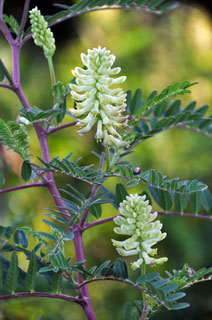CANADA MILK-VETCH
|
 |
| File Size: 87 KB |
|
|
|
Astragalus canadensis L.
|
| Konza Prairie, Riley County, Kansas |
| Perennial |
| Height: 16-60 inches |
| Family: Fabaceae - Bean Family |
| Flowering Period: June, July, August |
|
| Stems: | | Erect to ascending or sometimes prostrate, 1 to few, robust, solid or hollow, often branched above, pubescent with ax-shaped hairs or glabrous. | | Leaves: | | Alternate, odd-pinnately compound, 2 to 14 inches long, short-stalked to sessile; stipules united, triangular, tapering-pointed, 1/8 to 3/4 inch long; leaflets 13-35, narrowly lanceolate to oblong, ovate, or elliptic, 2/5 to 1.6 inch long, 1/6 to 3/5inch wide; under surface with ax-shaped hairs; margins entire, tip rounded; base rounded or pointed. | | Inflorescences: | | Raceme, dense, many-flowered, 1 to 8 inches long, terminal on stalks from leaf axils; stalks stiffly-upright; flowers bent downward, overlapping. | | Flowers: | | Short-stalked; calyx tube 1/6 to 1/3 inch long, stiff-hairy or glabrous, pouch-like base on upper side; teeth linear, tapering-pointed; corolla slender, papilionaceous, 1/2 to 3/4 inch long, greenish-white or cream, sometimes tinged with purple; banner 2/5 to 3/5 inch long, bent back slightly; wings slightly shorter, clawed; keel 1/3 to 1/2 inch long, clawed; stamens 10, arranged in 2 sets | | Fruits: | | Pods, numerous, ascending or erect, short-cylindrical to ellipsoid, 2/5 to 3/5 inch long excluding beak, 1/5 to 1/4 inch wide, glabrous or rarely fine-hairy; seeds heart- to kidney-shaped, about 1/12 inch long, smooth, brown. | | Habitat: | | Open woods, stream and river banks, moist prairies, roadsides, rocky or sandy thickets. | | Distribution: | | Throughout Kansas | | Origin: | | Native | | Uses: | | Native Americans applied a poultice of chewed roots to cuts and chewed the roots for chest and back pains; steeped the roots and used the tea to treat fevers and coughs; ate the roots fresh or boiled; and used the whole plant as a mat between freshly butchered meat and the ground. Small boys would use the stalks of pods as rattles in imitation of ceremonial dances. | | Comments: | | Canada milk-vetch often forms patches. "Milk-vetch" is an Old English name alluding to the belief that goats increased milk production after consuming these plants. Old French Veche, a corruption of Latin vicia, a name used to refer to plants of the Bean Family that have tendrils. |
|
| Canada milk-vetch |  | | 72 KB | | Konza Prairie, Riley County, Kansas |
| | Canada milk-vetch leaf |  | | 86 KB | | Konza Prairie, Riley County, Kansas |
| | Canada milk-vetch inflorescence |  | | 51 KB | | Konza Prairie, Riley County, Kansas |
| | Canada milk-vetch leaf |  | | 56 KB | | Wildcat Glades Conservation & Audubon Center, Newton County, Missouri |
| | Canada milk-vetch leaflets |  | | 52 KB | | Wildcat Glades Conservation & Audubon Center, Newton County, Missouri |
| | Canada milk-vetch fruit |  | | 60 KB | | Wildcat Glades Conservation & Audubon Center, Newton County, Missouri |
| | Canada milk-vetch |  | | 68 KB | | Konza Prairie, Riley County, Kansas |
| | Canada milk-vetch |  | | 56 KB | | Konza Prairie, Riley County, Kansas |
| | Canada milk-vetch |  | | 149 KB | | Konza Prairie, Riley County, Kansas |
| | Canada milk-vetch |  | | 96 KB | | Wildcat Glades Conservation & Audubon Center, Newton County, Missouri |
|
|
|
|
|
|
|












